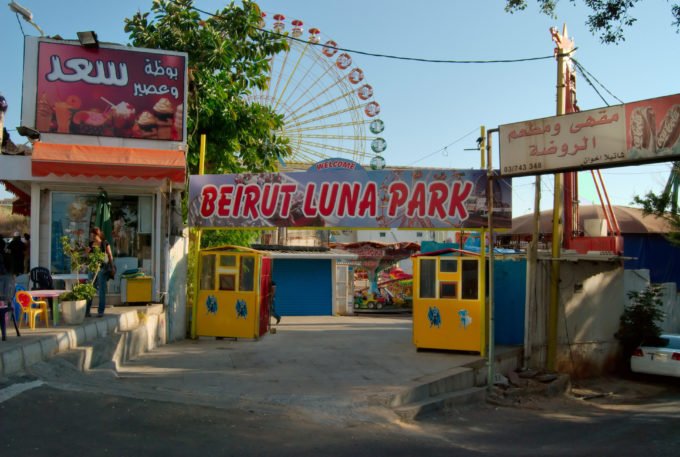
The park has weathered more than its share of storms, both meteorological and manmade.
The Ferris wheel at Luna Park, while delightful, isn’t something one can only experience in Beirut. The Ferris wheel was famously invented for the 1893 Chicago World’s Fair, and there are amusement parks all over the world called Luna Park, after the original at New York’s Coney Island.
Not only that, Beirut’s Luna Park Ferris wheel is probably in greater disrepair than many of its peers (at least judging from its appearance; I have not interviewed the ride’s maintenance team). The ride is held together by rusty metal that creaks ominously as the wheel turns, sometimes punctuated by startling jerks and stalls.
Beirut’s Luna Park and its star attraction have earned the right to be crappy, though. The park was constructed in 1966 by Noureddine Al Rifai (a member of the entrepreneurial Al Rifai family, also behind the largest nut-retailing chain in the Middle East), along the rocky cliffs of Beirut’s seafront, as part of a wave of construction to serve a new influx of tourists from the Arabian Gulf and Europe. According to the park’s supervisor, the Ferris wheel was largely constructed by Al Rifai himself when the park opened.
The park has weathered more than its share of storms, both meteorological and manmade. The park stayed open during most of the Lebanese civil war, when families would visit the fair during ceasefires for a respite from the violence. Spared from Israeli bombardment during the 2006 summer war that significantly damaged the lighthouse just a few hundred yards away, the park suffered nearly $700,000 USD in damage from a car bomb assassination in 2007 that killed MP Walid Eido and four others.
Rumor has it that the Ferris wheel became unmoored several times during the civil war and rolled off a cliff into the sea, where it was collected and reinstated. (Perhaps this explains some of the rust?) The wheel was also blown over during a sandstorm in the 1990s. The park’s supervisor declined to discuss any of these reports; it’s been hard enough attracting fun-seekers without stirring up old scandals.
Walking into Luna Park on a weekend afternoon, the park is a cross section of Beirut society. There are teenagers from the nearby American University of Beirut, self-segregated by gender; women in headscarves with their husbands and children; and South Asian families in which the parents work in Lebanon as domestic servants or laborers. It only costs a few thousand Lebanese pounds to ride the Ferris wheel (1,500 Lebanese lira = $1 USD), but some parents still send their children on alone. Despite an uptick in tourism this year, the Lebanese economy is hard on wage earners.
Reaching the apex of the Ferris wheel is a thrill, and not just because you’ve become suddenly hypersensitive to the every creak. The view of Beirut’s coastline is magnificent; the best you can get outside an airplane. The lighthouse at AUB is north, Beirut’s famous Pigeon Rocks are south, and the tony tower complexes of the Corniche stretch away toward the public white-sand beach around the curve of the coastline. At sunset the neon lights of the wheel begin to flicker on, standing out against the gathering dark. The sky is purple against the mercurial silver Mediterranean; you remember you’re in Beirut after all.